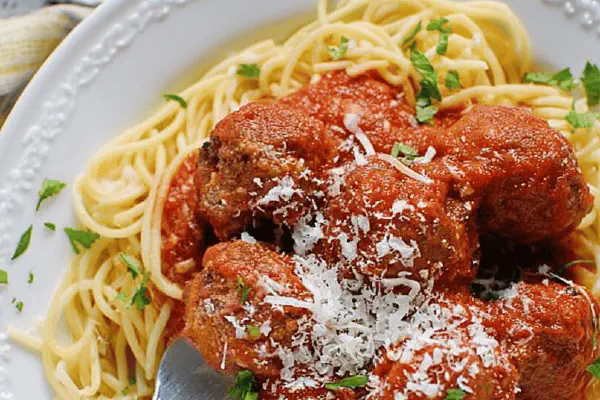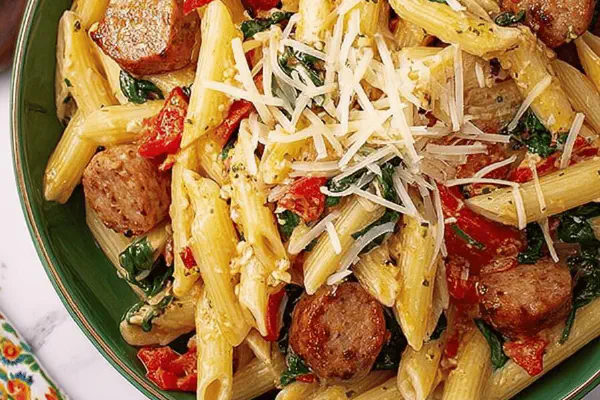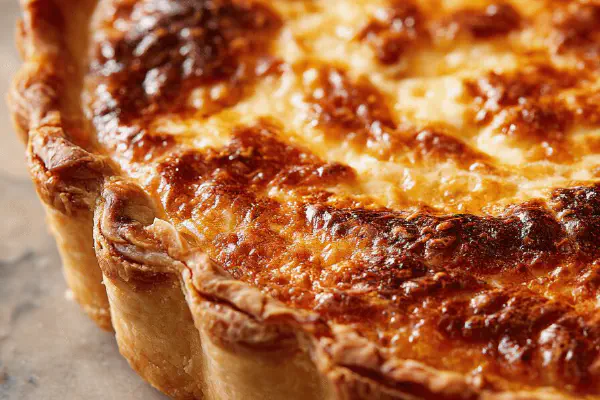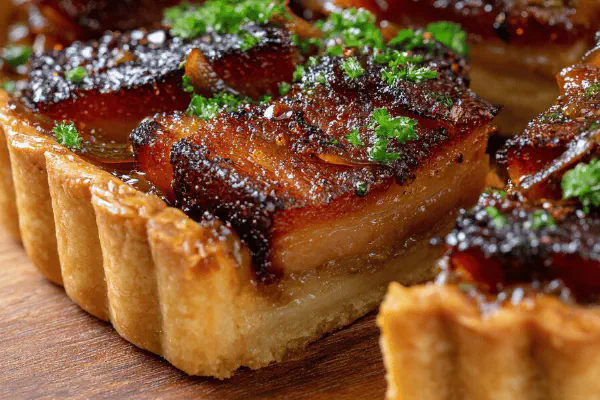Peperoncini Sausage Stromboli
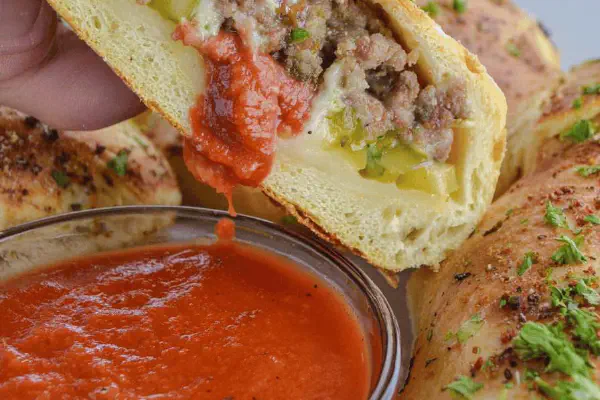
By Emma
Certified Culinary Professional
Ingredients
- 1 pound pizza dough
- 12 oz ground sausage (mild or spicy)
- 1 medium onion, finely chopped
- 4 oz goat cheese (substitute for original feta)
- 1 cup shredded mozzarella cheese
- 5-6 pepperoncini peppers, chopped
- 2 tablespoons olive oil (instead of egg wash)
- 1 tablespoon heavy cream (optional for brushing)
- Fresh parsley, minced
- Maldon salt or flaky sea salt
- Marinara sauce, for serving
About the ingredients
Method
- Preheat oven to 405 F with baking sheet or pizza stone inside. Preheating stone crucial; crispens bottom crust fast.
- Roll dough on floured surface to around 16 inches long by 8 inches wide. Thin enough to fold snug, not tear.
- Cook sausage in skillet till just browned, drain fat. Saute onions in same pan until translucent and sweet; helps avoid soggy filling.
- Layer cooked sausage, sauteed onions, chopped pepperoncini, goat cheese crumbles, and shredded mozzarella in center lengthwise. Don’t overfill—need room to fold.
- Fold long sides over filling, tuck ends under. Flip carefully so seam is bottom. Use hands to seal edges—pressure matters to trap juices.
- Cut 5-6 slits on top with sharp knife or razor. Steam vents stop sogginess, help crisp crust. No vents? Soggy bottom.
- Brush top with olive oil mixed lightly with cream if using. Skip egg wash—oil browns better and crisps over time.
- Slide stromboli onto heated stone or baking sheet. Bake 15-20 minutes until golden brown and dome sounds hollow when tapped gently with wooden spoon.
- Optional: sprinkle extra mozzarella on top last 2 minutes if you want melty cheese crown. Watch carefully—burns fast here.
- Remove from oven. Let rest on rack 5 minutes minimum. Internal steam redistributes, avoids gooey mess when slicing.
- Slice with serrated knife. Serve with warm marinara on side. Sprinkle parsley and flaky salt over slices for extra zip.
Cooking tips
Chef's notes
- 💡 Preheat oven with stone or sheet inside. Either helps crisp bottom fast. Skip preheat? Soft crust waits for no one. Rolling dough even thickness stops lumps that burn or undercook. Thin but tough enough to fold snug. Tear ruins steam trap, makes mess. Sausage browning comes first; drain fat. Fat overload ruins crust texture, sogs inside. Onions translucent, not raw; adds sweetness without extra moisture. Cool filling before folding if hot—dough snaps. Slash top 5-6 times sharp knife; vents stop ballooning. Oil brushing over egg wash browns crust more evenly and crisp longer. Skip egg-smell if you want simple savory crust. Resting after bake redistributes steam inside; slice too soon and juices run out. Listen for hollow tap on top with wooden spoon; sound signals readiness. Marinara on side balances fat and salt without drowning stromboli in sauce. Parm missing? Pecorino used here for sharp salt punch. Puff pastry sub okay but expect less chew, adjust baking time accordingly.
- 💡 Filling too wet? Use drier cheese or drain peppers well. Goat cheese tangier than feta, melts in patchy pockets; swap for blue if daring or ricotta for creaminess. Pepperoncini acid key—banana peppers milder, jalapenos shift heat profile. Mozzarella shredded better than sliced for even melt coating dough. Brushing a splash of cream mixed with oil enriches browning but optional. Dough stickiness calls for flour on rolling surface or hands; too much kills fold elasticity. Seal edges firmly like letter folds; pressure traps juices. Flip seam side down onto baking surface; prevents unfolding while baking. Slits on top essential—no vents, soggy crust guaranteed. Adding extra mozzarella in final two minutes creates gooey crown but watch careful, burns fast. Rest at least 5 minutes minimum on rack to firm internal texture before slicing.
- 💡 Oven temps vary wildly—405°F a guideline. Watch crust color. Too pale? Longer bake but risk drying out filling. Too dark? Shorten next bake. Thickness changes timing; thick dough needs longer but watch filling heat. Thin dough bakes faster, needs cautious timing or tears. Listen for oven sounds—hollow ‘thunk’ on top is your doneness bell. Using stone drastically improves bottom crisp from past attempts on sheet alone. Olive oil brushing develops crisp sheen plus subtle flavor nuance without egg taste interference found in other washes. Dough can be from scratch or store-bought; adjusting flour amount during rolling key to managing stickiness and pliability. Parsley finishing adds freshness; dried herbs lack that punch.
- 💡 Resting isn’t optional—cutting straight from oven means juicy mess and lost flavor. Internal steam redistribution happens fast but must. Slice with serrated knife to avoid crushing crust edges. Marinara sauce must be thick; watery sauce ruins bottom crust crispness by seeping in. Storage in airtight container keeps crust from softening but best eaten same day. Reheat in oven or toaster oven to restore crisp texture; microwaving ruins chew and crisp. If you skip cooling—cut fast—you lose steam control and get soggy layers that collapse under pressure.
- 💡 Substitutions are common—ground turkey for lighter protein but moisture changes filling texture. Blue cheese, ricotta, or feta swaps change tang and melt factor noticeably. Pepperoncini swaps must mind acid and heat; banana peppers less spicy, jalapenos more so. Heavy cream in brush optional for richer brown, skip for simpler oil only. Salt finishing essential; Maldon or flaky sea salt adds texture contrast on top and flavor pop. Dough flaws cause cracks or doughy result—adjust flour and rolling pressure accordingly. Always seal edges tight, steam trapped inside prevents drying. Bake time adaptability essential; ovens differ, learn cues by sound/color not just clock.
Common questions
How to prevent soggy crust?
Preheat stone or sheet fully. Use slits as vents. Drain excess fat from sausage. Avoid watery sauce underneath. Brush top with oil not butter or egg. Rest after bake lets steam settle inside crust before cutting. No vents or wet filling = soggy bottom guaranteed.
What cheese can replace goat cheese?
Feta if less sharp okay, ricotta for creamier texture but less tang. Blue cheese for bolder, funkier flavor. Keep in mind melting qualities vary. More moisture means watch folds tight and vent slits extra carefully. Goat stays tangy mid-point.
How to tell stromboli is done?
Color cues first—golden brown, especially edges. Tap top lightly with wooden spoon. Hollow sound means internal steam escaped evenly, filling cooked. Listen closely, ovens differ. Underbake and dough feels soft when tapped. Overbake—too hard, dryness inside. Bake 15-20 mins typical, adjust by sight and sound.
Storage options?
Cool completely; store airtight in fridge if saving. Reheat in oven or toaster for crisp return. Microwave ruins texture; crust soggy, chewy rubbery crust result. Leftovers up to 2 days best. Wrap tight to avoid drying. Freeze raw or cooked but thaw fully before reheating for even heating.
